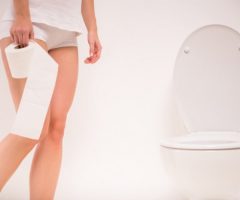Urinary incontinence 101

Nobody wants to talk about it, but it happens – involuntary peeing, also called urinary incontinence. It is estimated that at least 10% of Canadians experience urinary incontinence at some point in their lives.
Types of urinary incontinence
The three most common types of urinary incontinence are stress, urge and mixed urinary incontinence. Have you ever accidentally peed during exercise or while sneezing or coughing? That’s stress urinary incontinence. It’s the most common type, affecting 50% of patients with incontinence. Urge incontinence occurs in 14% of all cases of urinary incontinence. It’s the loss of bladder control accompanied by a sudden, strong urge to pee. Mixed urinary incontinence is a combination of stress and urge urinary incontinence and occurs in 32% of all incontinence cases.
Less common types of urinary incontinence include overflow incontinence, constant dribbling of urine, and functional incontinence, caused by a physical or mental condition that keeps patients from making it to the toilet in time.
Causes
Urinary incontinence is a symptom that can be caused by lifestyle factors, medications, medical conditions or physical problems.
Causes of temporary urinary incontinence
Foods and beverages can impact the bladder, stimulating the bladder to “go” and/or increasing urine volume. The most common culprits are alcohol, caffeine, carbonated drinks, chocolate and extremely spicy, sweet or acidic foods (e.g. chili peppers and citrus fruits).
Other causes of temporary urinary incontinence include medications (blood pressure medication, muscle relaxants and sedatives), urinary tract infections and constipation.
Causes of chronic urinary incontinence
Any damage or deterioration of the pelvic floor muscles or the tissues of the bladder can result in long-term urinary incontinence. Age is the most common risk factor. As we age, our bladder muscles change, bladder capacity decreases and involuntary bladder contractions increase. It’s estimated that 30% to 60% of adults over 65 have urinary incontinence.
In women, childbirth, hysterectomy and hormonal changes during pregnancy and menopause can cause stress urinary incontinence. In men, an enlarged prostate, prostate cancer or prostate cancer treatments can cause urinary incontinence.
Other, less common causes include obstruction of the urinary tract (tumors, urinary stones) and neurological disorders (e.g. multiple sclerosis and Parkinson’s disease).
What to expect when you see a urologist
It’s important to see your family doctor if you have persistent urinary incontinence. Not only does it impact your quality of life, it may also be a symptom of a serious medical condition. Your family doctor can refer you to see a urologist for further assessment and treatment.
At the urology appointment
You can expect your urologist to review your medical history and symptoms and do a physical exam. The urologist may examine you with a full bladder and ask you to cough to trigger incontinence. In order to properly diagnose the type and cause of urinary incontinence, you may also be asked to complete the following:
- urine test (urine analysis)
- symptoms or quality of life questionnaire
- bladder/voiding diary
- urine volume tests
- PSA test (men only)
- cystoscopy
- urodynamic tests
Treatment
For many people, simple lifestyle changes solve incontinence issues. Your physician will begin by suggesting the most conservative (least invasive) treatment options, including behavior modification and pelvic-floor muscle training.
Behavior modification
- Regular, scheduled toilet times
- Fluid restrictions
- Smoking cessation
- Avoidance of caffeine and foods and beverages that impact bladder control
- Bladder training
- Treatment for constipation
- Weight loss
- Treatment for chronic cough
Along with behavior modification and muscle training (Kegel exercises), you may be prescribed medications that help with incontinence. Typically, a medication will be trialed for 4 to 12 weeks to determine if it is helpful.
Management
Many patients find the following temporary solutions to urinary incontinence are helpful for maintaining quality of life.
- Pessary – A silicone ring or disc that can be inserted into the vagina and worn throughout the day. It prevents leakage by supporting the bladder.
- Urethral insert – A small, tampon-like, disposable insert that can plug the urethra. It is used during incontinence-triggering activities, such as playing sports.
- Absorbent pads or undergarments
- Catheter – A soft, flexible tube that is inserted into the urethra that helps drain the bladder.
If conservative treatment methods aren’t working, you may be a candidate for the following.
- Electrical stimulation of the rectum or vagina to strengthen pelvic floor muscles
- Interventional therapies, such as Botox bladder injections, sacral nerve stimulation or injection of supportive material around the urethra
- Surgery
Urinary incontinence can be an annoying and embarrassing problem. Fortunately, there are many options for treatment and management. Talk to your doctor about the best options for you.





